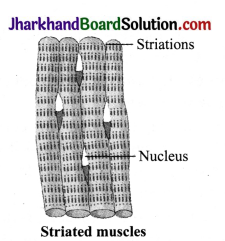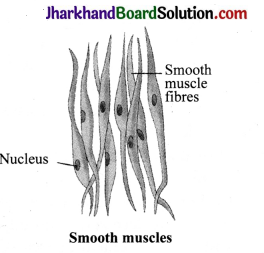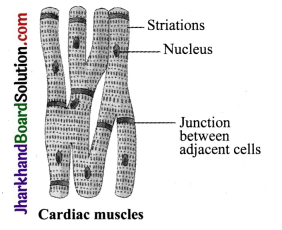JAC Board Class 9th Science Solutions Chapter 6 Tissues
JAC Class 9th Science Tissues InText Questions and Answers
Page 69
Question 1.
What is a tissue?
Answer:
A group of cells that are similar in structure and work together to achieve a particular function is called a tissue.
Question 2.
What is the utility of tissues in multicellular organisms?
Answer:
In multicellular organisms, different types of tissues perform different functions. Since a particular group of cells carries out only a particular function, these cells do it very efficiently. So, multicellular organisms possess a definite division of labour.
Page 74
Question 1.
Name types of simple tissues.
Answer:
The types of simple tissues are parenchyma, collenchyma and sclerenchyma.
Question 2.
Where is apical meristem found?
Answer:
Apical meristem is found at the tip of root or shoot of the plant.
Question 3.
Which tissue makes up the husk of coconut?
Answer:
The husk of coconut is made of sclerenchyma tissue.
![]()
Question 4.
What are the constituents of phloem?
Answer:
Phloem is made up of four types of elements sieve tubes, companion cells, phloem fibres and phloem parenchyma.
Page 77
Question 1.
Name the tissue responsible for movement in our body.
Answer:
The combination of both muscular tissue and nervous tissue is responsible for movement in our body.
Question 2.
What does a neuron look like?
A neuron consists of a cell body with a nucleus and cytoplasm. It has two important extensions known as the axon and dendrites. An axon is a long thread – like extension of nerve cells that transmits impulses away from the cell body. Dendrites, on the other hand, are thread-like extensions of cell body that receive nerve impulses. Thus, the axon transmits impulses away from the cell body, whereas the dendrite receives nerve impulses. This coordinated function helps in transmitting impulses very quickly.

Question 3.
Give three features of cardiac muscles.
Answer:
Three features of cardiac muscles are as follows:
- Cardiac muscles are involuntary muscles that contract rapidly but do not get fatigued.
- The cells of cardiac muscles are cylindrical, branched and uninucleate.
- They control the contraction and relaxation of the heart.
Question 4.
What are the functions of areolar tissues?
Answer:
Areolar tissue helps in supporting internal organs. It helps in repairing the tissues of the skin and muscles.
JAC Class 9th Science Tissues Textbook Questions and Answers
Question 1.
Define the term ‘tissue’.
Answer:
Group of cells that are similar in structure and perform same function is called a tissue.
Question 2.
How many types of elements together make up the xylem tissue? Name them.
Answer:
Tracheids, vessels, xylem parenchyma, and xylem fibres.
Question 3.
How are simple tissues different from complex tissues in plants?
Answer:
Simple tissues are made up of one type of cells which coordinate to perform a common function. Complex tissues are made up of more than one type of cells. All these coordinate to perform a common function.
Question 4.
Differentiate between parenchyma, collenchyma and sclerenchyma on the basis of their cell wall.
Answer:
| Parenchyma | Collenchyma | Sclerenchyma |
| Cell walls are relatively thin, and the cells in parenchyma tissues are loosely packed. | The cell wall is irregularly thickened at the corners and there is very little space between the cells. | The cell walls are uniformly thickened and there is no intercellular space. |
| The cell wall in this tissue is made up of cellulose. | Pectin and hemi – cellulose are the major constituents of the cell wall. | An additional layer of the cell wall composed mainly of lignin is found. |
Question 5.
What are the functions of the stomata?
Answer:
The outermost layer of the cell is called epidermis and is very porous. These pores are called stomata The stomata help in transpiration and exchange of gases.
Question 6.
Diagrammatically show the difference between the three types of muscle fibres.
Answer:
1. Striated muscles
(a) They are connected to bones (skeletal muscles).
(b) They are voluntary muscles.

(c) The cells are long, cylindrical with many nuclei and are unbranched.
2. Smooth muscles
(a) They are found in alimentary canal and lungs.
(b) They are involuntary muscles.

(c) They are spindle in shape and have single nucleus.
3. Cardiac muscles
(a) They are found in heart.
(b) They are involuntary in action.

(c) They are branched and have one nucleus.
Question 7.
What is the specific function of cardiac muscle?
Answer:
The specific function of cardiac muscle is to contract and relax rhythmically throughout life. Their rhythmic contraction and relaxation helps in pumping action of heart.
Question 8.
Differentiate between striated, unstriated and cardiac muscles on the basis of their structure and site/location in the body.
Answer:
| Striated muscles | Unstriated muscles | Cardiacmuscles |
| Cells are long, cylindrical, non – tapering and are unbranched. | Cells are long with tapering ends and are unbranched. | Cells are non – tapering and cylindrical in shape and are branched. |
| In hands, legs and skeletal muscles. | The wall of stomach,intestine, ureter, bronchi, etc. | In the heart. |
| Light and dark bands are present. | Absent | Present but less prominent. |
Question 9.
Draw a labelled diagram of a neuron.
Answer:

Question 10.
Name the following:
(a) Tissue that forms the inner lining of our mouth
(b) Tissue that connects muscle to bone in humans
(c) Tissue that transports food in plants
(d) Tissue that stores fat in our body
(e) Connective tissue with a fluid matrix
(f) Tissue present in the brain
Answer:
| (a) Tissue that forms the inner lining of our mouth | Epithelial tissue (squamous epithelium) |
| (b) Tissue that connects muscle to bone in humans | Tendons |
| (c) Tissue that transports food in plants | Phloem |
| (d) Tissue that stores fat in our body | Adipose tissue |
| (e) Connective tissue with a fluid matrix | Blood |
| (f) Tissue present in the brain | Nervous tissue |
Question 11.
Identify the type of tissue in the following: skin, bark of tree, bone, lining of kidney tubule, vascular bundle.
Answer:
Skin – Striated squamous epithelial tissue Bark of tree – Simple permanent tissues Bone – Connective tissue Lining of kidney tubule – Cuboidal epithelial tissue
Question 12.
Name the regions in which parenchyma tissue is present.
Answer:
Parenchyma is found in cortex and pith of root and stem. When it contains chlorophyll, it is called chlorenchyma, found in green leaves.
![]()
Question 13.
What is the role of epidermis in plants?
Answer:
Epidermis is present on the outer surface of the entire plant body. The cells of the epidermal tissues form a continuous layer without any intercellular space. It performs the following important functions:
- It is a protective tissue of the plant body.
- It protects the plant against mechanical injury.
- It allows exchange of gases through the stomata.
Question 14.
How does the cork act as a protective tissue?
Answer:
Cork acts as a protective tissue because its cells are dead and compactly arranged without intercellular spaces. They have deposition of suberin on the walls that makes them impervious to gases and water.
Question 15.

Answer:
